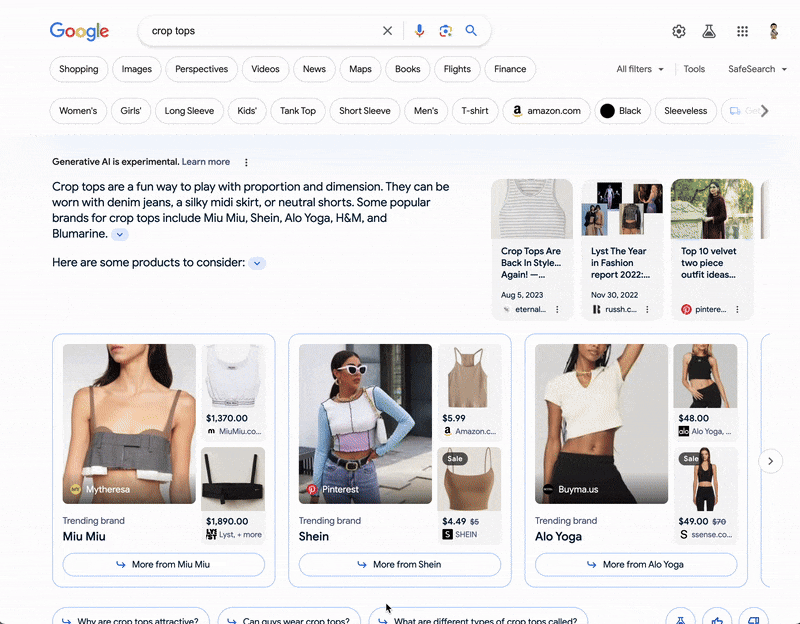The digital landscape is experiencing a significant shift due to the rise in zero-click search. This phenomenon, in which users find information directly on search engine results pages (SERPs) without clicking through to websites, is fundamentally changing how consumers engage with brands. Recent studies have shown that zero-click searches are becoming more common, which presents significant challenges for e-commerce businesses.
Traditional SEO and content marketing strategies, while still valuable, are facing increasing challenges in today’s competitive digital landscape. The rise of paid advertising, algorithm updates, and changing consumer behavior have made it more difficult for businesses to achieve organic traffic growth.
Nonetheless, it’s important to recognize that zero-click search isn’t all negative; it also provides opportunities for those who can effectively provide value within the SERP itself. A study by FirstPageSage found that the top three organic search results receive more than two-thirds (68.7%) of all clicks on the Google search page, suggesting a substantial opportunity for e-commerce businesses to connect with consumers through SEO.
This article explores the impact of zero-click search on the e-commerce industry, analyzing the challenges and opportunities that arise. By gaining a comprehensive understanding of zero-click search and the changing role of search engines, e-commerce businesses can develop strategies to optimize their online presence and succeed in this new era. Let’s get started, armed with knowledge and prepared to adapt!
Understanding the zero-click search landscape
Zero-click search occurs when users find the information they need directly on the SERPs without clicking through to a website.
This change in user behavior has been accelerated by search engine technology advancements, which now prioritize delivering immediate and comprehensive answers. The emergence of AI Overviews, which provides AI-generated summaries and potential follow-up questions directly within the SERP, has further intensified this trend, reducing the need for users to click through to individual websites.
In the context of e-commerce, this could be good and bad. On one hand it means that prospective customers can access product details, prices, reviews, and even make purchases directly from search results without having to visit the e-commerce website.
For instance, a user searching for “crop tops” might come across a selection of products with all the information they could need such as prices, ratings, and store availability, all without needing to visit a specific retailer’s website.
On the other hand, this could be bad news for your placement in the SERPs. As clicks have an impact on search rankings, with less people clicking through to your site, you could potentially see your site lose its place.
Key players in zero-click search
Expanding on the concept of zero-click search, it is important to understand the specific elements that make this phenomenon possible. These features, created by search engines, play a crucial role in offering users instant answers and reducing the necessity for visiting websites. Let’s delve into the main components of the zero-click search landscape:
- Featured snippets: Concise, informative summaries of a webpage that often appear at the top of search results, providing direct answers to user queries. For example, a featured snippet for “best coffee maker” might provide a list of top-rated coffee makers with key features and prices.
- Knowledge panels: Information boxes on the side of the SERP that offer detailed information about entities such as people, places, or things. For example, a knowledge panel for a popular retail brand, link LN-CC below, might display product images, pricing, and store locations.
- Rich results: Enhanced search results, such as product listings, recipes, or event details, that can provide sufficient information for users without clicking through to a site. Product carousels, for example, showcase multiple products with images, prices, and ratings.
- Voice search: The increasing use of voice assistants often results in direct answers being provided without explicit search queries. Example: A user asking Siri or Alexa “What’s the weather like today?” might receive a direct answer without visiting a weather website.
Collectively, these elements have transformed the SERP into a highly competitive landscape in which businesses must optimize their content to capture visibility and engagement.
E-commerce opportunities in a zero-click world
Zero-click search can be seen as a challenge for e-commerce businesses at first, but it actually offers a great opportunity to boost brand visibility and authority.
By creating high-quality, informative content that directly addresses user queries, e-commerce websites can improve their chances of being featured in snippets and rich results. This prime placement provides unmatched exposure to a specific audience.
Moreover, the key to winning in the zero-click search landscape lies not only in content creation but also in meticulous data curation and enrichment. By carefully curating and enhancing product data – including detailed specifications, high-quality images, user reviews, and comprehensive metadata – e-commerce businesses can provide search engines with the complete, structured information they need to generate informative zero-click results.
Maintaining a consistent presence in these formats can establish a brand as a reliable source of information, thus building credibility and customer loyalty.
Furthermore, zero-click search can be a potent lead-generation tool. Even though users may not be immediately ready to make a purchase, being exposed to a brand through featured snippets can raise awareness and interest. This can nurture potential customers and encourage them to revisit the website when they are ready to buy.
The combination of strategic content creation and thorough data management allows e-commerce businesses to not only be consistently present in search results, but it also positions the brand as an authority in its field.
By focusing on delivering exceptional value through both content and data, and comprehensively addressing user needs, e-commerce businesses can capitalize on zero-click search to drive sustained growth and success in an increasingly competitive digital marketplace.
[Ebook] 5 KPIs that reveal top strategies for successful ecommerce SEO
Optimizing your e-commerce site for zero-click success
While content creation and data management are essential for a successful zero-click search strategy, e-commerce businesses must focus on optimizing their sites to make sure search engines can access it all.
Structured data: The foundation for rich results
Structured data is the language that helps search engines understand your website’s content: it’s crucial for achieving rich results.
By implementing schema markup, you provide clear signals to search engines about your products, prices, availability, reviews, and more. This enhances the likelihood of your information appearing in rich snippets, product carousels, and other visually appealing formats.
Building an extensive knowledge graph
As mentioned above, a knowledge graph is a vast network of interconnected data that search engines use to understand entities and their relationships. They are essential for e-commerce businesses that wish to provide enriched user experiences.
For instance, in the eyewear industry, eye-oo initiated a strategic partnership focused on meticulous data curation and enrichment which led to significant organic growth and e-commerce success.
By leveraging structured data and enhancing product information with detailed specifications, high-quality images, and comprehensive metadata, the brand was able to achieve prominent SERP visibility.
This approach not only facilitated their appearance in rich snippets and knowledge panels but also established them as a reliable source of information, thereby boosting brand authority and customer trust.
Here are some actionable steps you can take to enhance your e-commerce site’s data management and visibility:
- Leverage merchant feeds Your product feed is a rich source of data that can be used to populate your knowledge graph. By structuring product information consistently and accurately, you can enhance a search engine’s understanding of your offerings.
- Direct optimization While merchant feeds are a valuable starting point, consider going beyond basic product information. Enrich your data with additional details such as product specifications, customer reviews, and usage instructions. This can help your products stand out in search results and provide more comprehensive information to users.
- External data sources Complement your product data with information from external sources. For example, incorporating data about product ingredients, nutritional facts, or compatibility can create a more comprehensive knowledge graph.
Content creation: Addressing user intent
Content creation remains a vital component of zero-click optimization. By understanding user intent and creating content that directly answers user queries, your chances of appearing in featured snippets increase.
Focus on creating informative and engaging content that goes beyond product descriptions. Consider incorporating blog articles, product guides, and FAQ pages to address common questions and concerns.
Similarly, in the broader e-commerce sector, optimizing brand SERPs through advanced data management techniques has been instrumental in enhancing online visibility.
By implementing schema markup and building a strong knowledge graph, brands can ensure that search engines can accurately interpret and display their content.
This strategy enables brands to capture valuable SERP real estate, thereby successfully navigating the challenges of zero-click search, maintaining a strong online presence and driving sustained engagement with potential customers.
By combining these strategies, e-commerce businesses can position themselves to thrive in the zero-click search landscape. Remember, continuous monitoring and adaptation are key to staying ahead of the curve.
What’s next: The future of zero-click search and e-commerce
The trend of zero-click search is clearly on the rise. As search engines become more advanced in understanding and predicting user needs, we can expect this trend to continue.
The integration of AI and machine learning is likely to lead to even more advanced features that directly provide comprehensive answers within search results. This evolution presents both challenges and opportunities for businesses.
While reliance on organic traffic may decrease, focusing on delivering exceptional value through content and data will become crucial. Adapting to this new landscape will require a strategic approach that prioritizes featured snippets, rich results, and a deep understanding of user intent.
Ultimately, the future of zero-click search is one where businesses must compete for visibility not only on websites but within the search engine results themselves. To succeed, e-commerce businesses must excel in content creation, data management, and user experience to ensure their brand is the preferred source for information and solutions.




